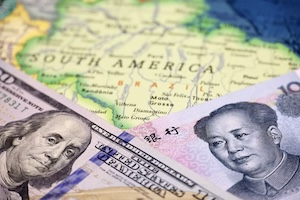
Donald Trump’s first term in office pursued an aggressive foreign policy toward China, imposing tariffs, restricting technology transfers, and accusing Beijing of unfair trade practices. However, one unintended consequence of this hardline approach has been China’s accelerated expansion into Latin America—a region traditionally within the U.S. sphere of influence. Now, three months into Trump’s second administration, the trend continues for Beijing to grow as the US weakens its trade relations.
China Dominates Key Sectors
China has cemented its position as South America’s top trading partner, surpassing the United States in trade volume with key economies like Brazil, Chile, and Peru. Beijing has become a major source of foreign direct investment, particularly in mining, agriculture, and technology, while its state-backed banks dominate energy and infrastructure lending across the region. Through its Belt and Road Initiative (BRI), China has financed and constructed highways, ports, dams, and 5G networks, deepening economic dependencies and expanding geopolitical influence. This strategic investment push—coupled with flexible, no-strings-attached loans—has made Beijing an indispensable partner for South American nations, even as concerns grow over debt sustainability and China’s long-term strategic ambitions in the Western Hemisphere.
China has become the largest export market in Brazil, surpassing the United States since 2009. Days after Trump’s reelection, the America First foreign policy allowed China to shine. At the Asia-Pacific Economic Cooperation forum in Peru, President Xi Jinping announced a $1.3 billion megaport that promises to be the gateway from South America to China. President Xi Jinping’s state visit to Brazil in November also highlighted a strengthening partnership, where 37 agreements across various sectors were signed. In Guyana, Chinese firms have invested in infrastructure projects such as hotels, bridges, and shopping centers, and are involved in mining activities in remote Amazonian areas. They also funded the renovation of the main international airport with a $150 million loan.
Energy
China has significantly expanded its presence in the “Lithium Triangle”—Argentina, Bolivia, and Chile—with a surge in investments in lithium mining, a critical resource for electric vehicles and advanced technology. Just this past February, China’s lithium company Ganfeng started producing lithium at its site in northern Argentina. This strategic move not only strengthens China’s dominance in the EV market but also reduces Western influence in a region traditionally aligned with U.S. interests. As demand for lithium continues to grow, China’s deepening foothold in these South American nations underscores its long-term economic and geopolitical ambitions.
Space
China’s growing technological footprint in Latin America has raised security concerns, particularly with its space tracking station in Argentina – originally built for civilian use in 2018 but now suspected by intelligence agencies of supporting military satellite surveillance operations. This strategic asset in the Southern Hemisphere complements Beijing’s expanding technological influence across the region. These developments demonstrate how China is leveraging dual-use space infrastructure and surveillance technologies to deepen security ties with sympathetic regimes, potentially enhancing its intelligence-gathering capabilities while exporting digital authoritarianism to America’s doorstep. The integration of these systems with China’s BeiDou satellite navigation network further strengthens Beijing’s strategic position in the Western Hemisphere, challenging traditional U.S. technological dominance in the region.
Bailouts and Debts
Following the Trump administration’s reinstatement of harsh economic sanctions, Cuba was forced to seek alternative allies, turning to China as its primary financial lifeline. Cuba’s Ministry of Energy and Mines has announced plans for eight new solar parks utilizing Chinese technology. The deal represents just one facet of China’s expanding influence in the Caribbean, where it has strategically filled the void left by U.S. disengagement, gaining both economic leverage and geopolitical footholds in America’s near abroad. As Cuba’s power infrastructure becomes increasingly tied to Chinese technology and financing, the arrangement illustrates how sanctions have inadvertently pushed Havana firmly into Beijing’s orbit.
The number of Chinese loans in Latin America, characterized by flexible terms and fewer conditions, has led to worries about debt sustainability. Countries like Argentina and Venezuela have accumulated substantial debt to Chinese creditors, leading to situations where they must export commodities like oil at discounted rates to service these debts.
Trade Relations Declining
While the US trade relations are declining, in part due to aggressive tariffs by the Trump administration and hard knuckling in negotiations, China’s investments in Latin America are continuing to grow. For the past twenty years, China has negotiated five free trade agreements with various countries in the region: Chile, Costa Rica, Ecuador, Peru, and Nicaragua. Beijing successfully upgraded its free trade agreements with Chile and Costa Rica in the past few years, enhancing market access for Chinese goods while securing preferential treatment for key imports like lithium and agricultural products. This growing divergence in trade policy approaches has allowed China to fill the vacuum left by U.S. economic disengagement, positioning itself as the primary commercial partner for an increasing number of Latin American nations seeking alternatives to traditional Western markets. The upgraded agreements not only strengthen China’s economic foothold but also provide Beijing with greater political leverage in a region historically considered America’s backyard.